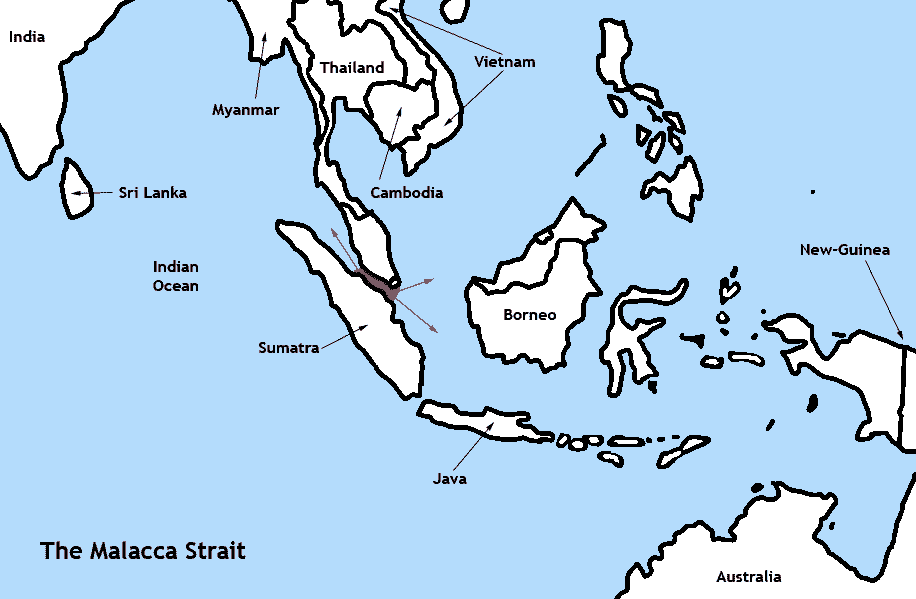The Strait of Malacca is located on the Western perimeter of the South China Sea. Running between the Eastern coast of the Indonesian island of Sumatra and the Western coast of Malaysia, it stretches 65-250 km wide and 800 km long. Despite the relatively narrow size, the Strait of Malacca is one of the world’s busiest straits for maritime shipping. As Asia, more specifically China and Southeast Asian countries, plays an increasingly important role in the global supply chain, both the economic and strategic importance of the Strait of Malacca will continue to increase in the forthcoming years.

The Strait of Malacca is not only important for regional countries as they benefit from the connectivity brought about by the geographic advantages of the strait. Global powers, such as the United States, the United Kingdom and France, currently also view, or have at some point in history also viewed, this strait as an equally important choke point as the Suez Canal, if not more. The US Navy has included the Strait of Malacca as one of the eleven critical choke points of global maritime shipping. The British Empire benefited from the shipping route between British Malaya (later Singapore and Malaysia) and Hong Kong during its prime time that boosted its trade with China and shipped countless valuable goods back to Europe. The Strait of Malacca was the only route that ensured British success in Asia at the time.
The Strait of Malacca continues to play an important role in global shipping, particularly in energy trade, as globalization pushes for an increasingly integrated global market. The rise of the Asian economies, including the economic success of Singapore, Malaysia, Japan, South Korea and, most importantly, China, has brought this strait unforeseeable amount of shipping volumes. This is particularly true during the first decade of the 21st century. That said, as economic power develops, power dynamics have also shifted dramatically in the region. Sitting on the Western perimeter of the South China Sea, the importance of the Strait of Malacca has often been brought up during the second decade of the 21st century when territorial and maritime disputes among regional claimants and the tensions resulting from the U.S.-China strategic competition stir up concerns over security and stability over maritime shipping in the region. Whether the South China Sea could remain as a holistically peaceful, calm region will greatly determine the future of the Strait of Malacca.
Furthermore, at the beginning of the third decade of the 21st century, concerns over resilience of global supply chains have also arisen. China, as a major growing economic power, has pushed for its Belt and Road Initiative (BRI) with an aim to boost both land-based and maritime-based connectivity between China and the world. Beijing has shown its ambition to include the Strait of Malacca into its grand view. That decision has met strong opposition from the United States, which sees Beijing’s BRI as an attempt to jeopardize openness and freedom of navigation in Asia.
As the only reliable shipping nexus that connects the South China Sea and the Indian Ocean, the stability of the Strait of Malacca has not only brought up discussions over how to manage the region but also by whom the region should be managed. Regional countries, including Singapore, Malaysia, and Indonesia, have similar yet still different ideas as to how the order of the Strait should be managed. Moreover, there are also other countries that seek to diversify, and therefore weaken the role of the Strait of Malacca by creating alternative shipping routes between the South China Sea and the Indian Ocean. There are several other small natural straits in the region, though none currently as clearly direct or ultimately useful as the Strait of Malacca. Thailand has made a pioneering attempt to dig up the Thai canal, also known as the Kra canal, to provide a different route from the Bay of Thailand to the Indian Ocean. That has not only brought concerns and discussions from China and the United States, but also India. One can only expect that the Strait of Malacca will become increasingly international as the balance of power continues to develop in the region.
This Spotlight was originally released with Volume 2, Issue 3 of the ICAS MAP Handbill, published on March 28, 2023.
This issue’s Spotlight was written by Yilun Zhang, ICAS Research Associate & Manager, Trade ‘n Technology Program.

Maritime Affairs Program Spotlights are a short-form written background and analysis of a specific issue related to maritime affairs, which changes with each issue. The goal of the Spotlight is to help our readers quickly and accurately understand the basic background of a vital topic in maritime affairs and how that topic relates to ongoing developments today.
There is a new Spotlight released with each issue of the ICAS Maritime Affairs Program (MAP) Handbill – a regular newsletter released the last Tuesday of every month that highlights the major news stories, research products, analyses, and events occurring in or with regard to the global maritime domain during the past month.
ICAS Maritime Affairs Handbill (online ISSN 2837-3901, print ISSN 2837-3871) is published the last Tuesday of the month throughout the year at 1919 M St NW, Suite 310, Washington, DC 20036.
The online version of ICAS Maritime Affairs Handbill can be found at chinaus-icas.org/icas-maritime-affairs-program/map-handbill/.

The Institute for China-America Studies is an independent nonprofit, nonpartisan research organization dedicated to strengthening the understanding of U.S.-China relations through expert analysis and practical policy solutions.
1919 M St. NW Suite 310,
Washington, DC 20036
icas@chinaus-icas.org
(202) 968-0595
© 2025 INSTITUTE FOR CHINA-AMERICA STUDIES. ALL RIGHTS RESERVED.